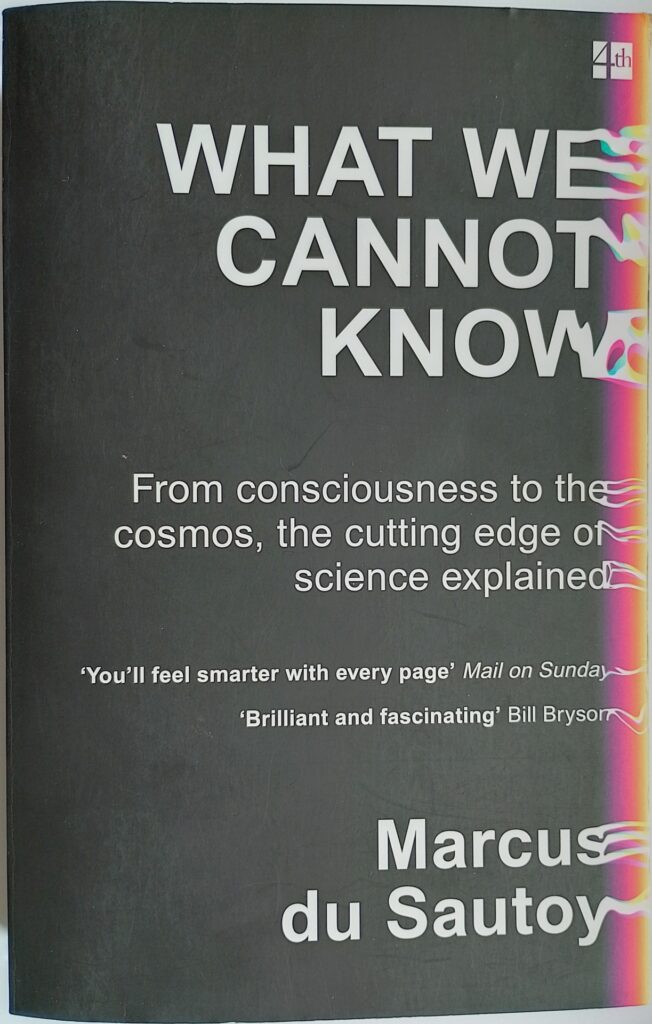First published 2016. 4th Estate, paperback, 2017, pp 440, c.150,000 words.
du Sautoy is a professor of Mathematics at Oxford University as well as Simonyi Chair for the Public Understanding of Science and has presented several television programmes, so he is well qualified as a communicator of science, and this book explores some of the cutting edge of science, as well as venturing into philosophy and religion.
The book attempts to map the boundaries of what it is possible for humans to ever understand. He explores these boundaries under seven themes, each section titled as an ‘edge’. The themes are:
- Predicting the outcome of seemingly random events such as how a thrown dice will land.
- What are physical objects made of? Can we know if quarks are made up of anything smaller, and is the physical realm ultimately a continuum or composed of discreet particles?
- Does quantum physics mean that ultimately the physical realm is only real in any human-understandable sense when we observe it?
- What is the extent of the Universe?
- Is time as steady and fundamental as we perceive it to be?
- What is consciousness?
- Are even statements in mathematics ultimately provably true, or do we always have to start with unprovable axioms?
It’s hard to know if this is an exhaustive list, but it is a heavy-duty one. du Sautoy dresses this up in non-threatening ‘edges’. So for example, the first section is labelled ‘The Casino Dice’ and the second ‘The Cello’. These two objects form the starting points for the subject and the lead-ins are all well handled with nicely turned anecdotes that provide a touchstone for what follows, which is always a dive down the rabbit-hole to determine where our understanding currently runs out and where there might conceivably be a boundary which is uncrossable. There is relevant history-of-science given to explain how we arrived at our current understanding. Most of this is very clear. He offers one of the best descriptions I have read on how the current ‘standard model’ of particles was arrived at.
There is a valiant attempt to explain quantum physics, but I came away no wiser as I have after reading several other authors’ attempts at the same subject. The problem is that the phenomena are so far outside our experience of the world that it is impossible for most of us to picture what is going on. There is nothing human scale that we can relate it to. ‘Shut up and calculate’ as one scientist told his ever-questioning students. All we can say is that the calculations produce results that are as accurate as we can measure experimental results.
The explanation of relativity fares better, but even so comes up with some mind-bending implications such as observing a shooting on a train by two assailants when it depends on who is doing the observing which determines which assailant fired first: a fine example of the less than solid nature of time. Again, relativity calculations produce results that are closer to observation than those from classical physics.
The most inaccessible section for me was the last, and perhaps this is because du Sautoy is a mathematician himself. I got the point, but my understanding, and acceptance, definitely lagged during the discussion of different types of infinity.
Overall this is a demanding book. Don’t expect to be able to race through if you want to get the most out of it. It is a big book in many ways, not least in length. The ideas he is dealing with are the big ones: the nature of reality, consciousness, the universe, time, etc. The writing is good, with a sprinkling of relevant (mostly) anecdotes to lighten the heavy stuff. When it comes to the nature of God, du Sautoy is rather inconclusive. Is God the name we give to the gaps in our knowledge? He interviews a couple of serious scientists who are also religious believers, but somehow they fail to deliver anything conclusive. Presumably their faith was built on something, but what they say here was not illuminating. Perhaps that is the nature of faith: like love, it just is.
This book was a massive undertaking and is hugely thought provoking. If you are up for the challenge, then it is highly recommended.
© William John Graham, September 2022

